A Novel Disturbance Observer Based Fixed-Time Sliding Mode Control for Robotic Manipulators With Global Fast Convergence
2024-03-04DanZhangJiabinHuJunChengZhengGuangWuandHuaichengYan
Dan Zhang ,,, Jiabin Hu , Jun Cheng , Zheng-Guang Wu ,,, and Huaicheng Yan ,,
Abstract—This paper proposes a new global fixed-time sliding mode control strategy for the trajectory tracking control of uncertain robotic manipulators.First, a fixed-time disturbance observer (FTDO) is designed to deal with the adverse effects of model uncertainties and external disturbances in the manipulator systems.Then an adaptive scheme is used and the adaptive FTDO (AFTDO) is developed, so that the priori knowledge of the lumped disturbance is not required.Further, a new non-singular fast terminal sliding mode (NFTSM) surface is designed by using an arctan function, which helps to overcome the singularity problem and enhance the robustness of the system.Based on the estimation of the lumped disturbance by the AFTDO, a fixed-time non-singular fast terminal sliding mode controller (FTNFTSMC)is developed to guarantee the trajectory tracking errors converge to zero within a fixed time.The settling time is independent of the initial state of the system.In addition, the stability of the AFTDO and FTNFTSMC is strictly proved by using Lyapunov method.Finally, the fixed-time NFESM (FTNFTSM) algorithm is validated on a 2-link manipulator and comparisons with other existing sliding mode controllers (SMCs) are performed.The comparative results confirm that the FTNFTSMC has superior control performance.
I.INTRODUCTION
WITH the further development of modern industry,robotic manipulators can not only assist humans to carry out mechanical automatic production, but also replace labours to complete dangerous industrial tasks, thus they can improve production efficiency and reduce safety problems.In recent years, due to the unique operational flexibility of robotic manipulators, they have received extensive attention in various fields, such as aerospace, medical treatment and logistics transportation [1]-[5].However, complex application scenarios require the robotic manipulators to have superior control performance.As a typical nonlinear system, the manipulator has a complex mechanical structure and it is easily affected by uncertain factors such as parameter perturbations, unmodeled dynamics and external disturbances [6].Therefore, it is necessary to design effective schemes to accurately control manipulators to satisfy practical application demands.
In the past few decades, various advanced control algorithms were studied to overcome nonlinear and uncertainty problems in robot systems, see, e.g., adaptive control [7], [8],fuzzy control [9], [10], backstepping control [11], [12] and sliding mode control [13], [14].It is known to all that sliding mode control can provide more excellent robustness than other control schemes, which makes it receive extensive attention.However, the traditional linear sliding mode (LSM)design can only ensure the asymptotic stability of the system,and the undesirable chattering is easy to deteriorate the control performance.Those defects have limited the application of sliding mode controllers (SMCs) in practical industry.In order to improve the control performance of dynamic systems and guarantee the finite-time convergence of system states,the terminal sliding mode (TSM) control scheme was proposed in [15].Although TSM control algorithms have gained popularity, it also has some shortcomings, that is, it is prone to singularity problem.By designing an appropriate fractional power in the sliding surface, a new finite-time control method with the non-singular TSM (NTSM) design was proposed in[16] to overcome the undesired singularity.Inspired by the work in [16], the non-singular terminal SMC (NTSMC) was designed in [17] to solve the trajectory tracking problem of manipulators with unknown uncertainties, and the satisfactory tracking performance was achieved.In addition, compared with NTSM control, the non-singular fast TSM (NFTSM)control introduced in [18]-[20] showed faster convergence speed in trajectory tracking.Noteworthily, finite-time sliding mode control for robotic manipulators has been extensively studied in the past few years, but a defect exists in the current finite-time control results, that is, the settling time of the tracking errors is constrained by the initial system states.For example, the finite-time sliding mode control strategy for robotic manipulators presented in [17] and [20] can guarantee a bounded settling time, but the settling time of the error system will increase when the initial state of the system is far from the equilibrium point.This shortcoming affects the global tracking performance of the robotic manipulator and limits the potential of finite-time control strategies in practical engineering.
Recently, some new fixed-time control methods were proposed and they immediately receive a lot of research attention,which ensures that the convergence of all system states is uniformly bounded and the upper bound of the convergence time is independent of the initial system states, see, e.g., [21]-[28].In [21], a fixed-time feedback control strategy for nonlinear dynamical systems was investigated, which guaranteed the global fixed-time stability.To solve the trajectory tracking problem ofn-link robotic manipulators, an adaptive fuzzy fixed-time control scheme was proposed in [23], in which an error conversion mechanism based on the system performance and a barrier Lyapunov function were designed.This fixed-time control strategy not only helps the manipulator system achieve rapid transient response, but also guarantees the boundedness of its closed-loop signals, thus improving the global convergence performance and confining the trajectory tracking error within the artificially set boundary.In [24], an adaptive fixed-time cooperative control scheme was proposed for multiple manipulator systems with position and velocity constraints, which guaranteed that the consensus tracking error of each intelligent body converged to a small neighborhood near the origin in a fixed time.With help of the above fixed-time control algorithm, the convergence performance of the manipulator is not constrained by the system state, thus eliminating the need for frequent changes in the control structure.Extending the fixed-time scheme to sliding mode control,a robust fixed-time SMC with variable exponential coefficients was recently proposed in [27], which can effectively deal with mismatched disturbances in nonlinear systems.By using nonlinear piecewise functions to overcome the singularity problem, a fixed-time SMC for robotic manipulators was proposed in [28] to ensure that tracking errors converged to a small field near zero within a fixed time.Note that this scheme does not achieve global fixed-time convergence of tracking errors and singularity avoidance process is very complex.In [29], an improved high-order SMC was used to achieve global fixed-time stability and fast state convergence.However, the above fixed-time SMC is not optimal, and unknown parameter perturbations and external disturbances have not been well dealt with.
As is well known, the system uncertainties and external disturbances are unavoidable in real systems, which will deteriorate the tracking performance of robotic manipulators.At present, many results related to robots mainly focus on how to eliminate the influence of those uncertain factors.The control scheme based on the disturbance observer (DO) is popular among existing research results, which can help strengthen the robustness of the system and improve the tracking accuracy,see, e.g., [30]-[33].More specifically, in [31], an asymptotic disturbance observer for robot systems was designed to estimate the unknown disturbance, which ensured the rapid convergence of tracking errors.In [32], an adaptive fuzzy integral sliding mode control strategy based on the disturbance observer was investigated for robot systems with parameter perturbations, external disturbances and actuator faults.However, the above design schemes cannot guarantee estimation errors converge within a fixed time, which is easy to affect the settling time of system states.Recently, research effort has been devoted onto improving those control performance in literature.In [34], a nonlinear disturbance observer was developed to estimate the lumped disturbance, which ensured that the estimation error converged within a fixed time.In addition, in order to speed up the convergence speed of robot systems, a fixed-time disturbance observer (FTDO) was proposed in [35]-[37] to solve the system uncertainty problem.However, the above design results are also not optimal in terms of estimation accuracy and convergence rate, and there are very few results reported on the FTDO, which motivates the current study.
Based on the foregoing discussion, a new fixed-time NFTSM control scheme based on an adaptive FTDO(AFTDO) for manipulators is proposed in this paper.Simultaneously, the major contributions of this paper are highlighted as follows:
1) Compared with the finite-time sliding mode control methods presented in [15]-[20], a new fixed-time NFTSM control strategy for robotic manipulators is proposed in this paper, which ensures that the trajectory tracking error can converge within a fixed time and the upper bound of the convergence time is independent of the initial state.Therefore, a better convergence performance is achieved, which can be found in the simulation study.
2) Compared with the existing NFTSM control methods introduced in [20], [26] and [28], a new NFTSM surface based on the arctan function is designed to overcome the singularity problem more simply and effectively, and there is no need to worry about the non-differentiability problem that may exist in the piecewise function.In addition, this new sliding surface ensures that the manipulator system can achieve faster trajectory tracking speed.
3) Compared with the traditional disturbance observers introduced in [31]-[33], which can only achieve asymptotic or finite-time stability, a new AFTDO is designed to ensure that the estimation error converges in a fixed time.Simultaneously, it is required in the existing FTDO designed in[34]-[37] that the prior knowledge of lumped disturbance must be known and it was difficult to provide satisfactory estimation accuracy.Compared with these results, the proposed AFTDO can achieve faster estimation speed and higher estimation accuracy, and does not need to know the perturbation bound in advance with the help of the adaptive law.
The remaining part of this paper is proceeded as follows.In Section II, the description of the problem and some preparatory knowledge are introduced.The design process of the fixed-time non-singular fast terminal SMC (FTNFTSMC) and the corresponding stability analysis are presented in Section III.In Section IV, the simulation results show that the proposed control strategy is feasible and provides superior control performance.This paper is summarized in Section V.
II.PROBLEM FORMULATION
A. Notations
Inthispaper, thefollowingsymbols are used.Foranyndimensionalvectorz=[z1,z2,...,zn]T∈Rn, ||z||denotesthe Euclidean norm of the vectorz.sig(z) is defined as sig(z)=[sign(z1),sign(z2),...,sign(zn)]T, where sign(*) is symbolic function.λmin{P} is the minimum eigenvalue of matrixP.
B. Lemmas and Definitions
Consider the following nonlinear system:
wherexdenotes the state variable, andf(x(t)) is a continuous nonlinear function.For any initial state, we assume that there is a unique solution for the system (1).
Definition 1[27]: If the system (1) satisfies: i) It is globally finite-time stable, ii) The settling timeT(z0) is bounded, and there exists a constantTmaxsuch thatT(x0)≤Tmax, then the system (1) is fixed-time stable.
Lemma 1[21]: For system (1), if there exists a Lyapunov functionV(x) satisfying
wherepγ <1,kγ >1, α , β,p,kand γ are positive numbers.Then the dynamic system is fixed-time stable.The settling time satisfies
Lemma 2[38]: Consider the nonlinear system in (1).If there exists a Lyapunov functionV(x) and positive scalars α,β,p,kand γ, such that
where ϑ >0.Then the dynamic system is practical fixed-time stable and the residual set of the solution is expressed as
where µ is a scalar, 0 <µ≤1.The settling time satisfies
Lemma 3[39]: For the vectorz=[z1,z2,...,zn]T∈Rn, it satisfies
wherei=1,2,...,n, 0 <ζ1<1 and ζ2>1.
C. Dynamics of the Robotic Manipulators
Consider the following dynamic equation for an-link rigid manipulator:

Property 1[40]:N(q),B(q,q˙) andG(q) are bounded and they satisfy
Property 2[41]: There are two positive scalars ξ1and ξ2such that the friction term satisfies
Then dynamic equation (9) is written as
whereDd=τd-F(q˙)-ΔNq¨-ΔBq˙-ΔG.
Through simplification, the dynamic model (12) is rearranged as
whereD=N0-1Dddenote a lumped disturbance.Before proceeding, the following assumptions are necessary.
Assumption 1[6]: The lumped disturbanceDis bounded,and there is a constant δ1>0 that satisfies
where ηa1, ηa2and ηa3are unknown positive numbers.
Assumption 2[42]: The first and second derivatives ofDwith respect to timetexist and are bounded, which is described as
where δ2and δ3are positive scalars.
Define the desired reference trajectory asqd, and the main purpose of this paper is: 1) Design a suitable sliding mode control scheme to ensure that the robotic manipulator given in(9) can overcome the system uncertainty and external disturbance, and finally accurately track the reference trajectory within a fixed time; 2) Eliminate the influence of chattering on the control performance.
Remark 1: From the perspective of control engineering,Assumptions 1 and 2 are reasonable.According to Properties 1 and 2, it is not difficult to infer that ΔN, ΔBand ΔGare bounded.In addition, the unknown disturbance τdis usually bounded in practical applications.Therefore, combined with[6], [19] and [20], the above assumptions can be satisfied.
III.MAIN RESULTS
A. Design Approach of a Novel FTDO
In this subsection, a new FTDO is designed as
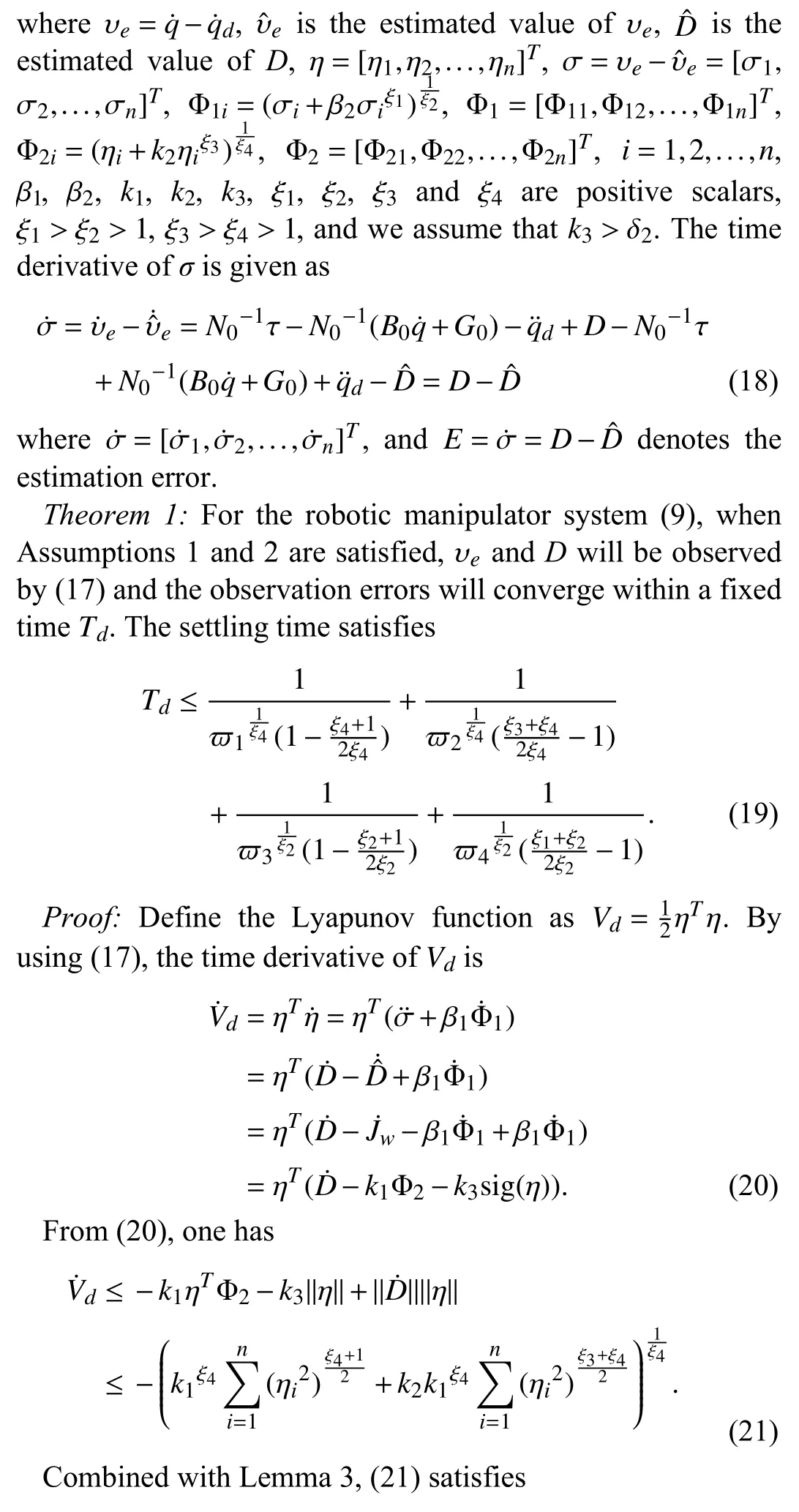

B. Design Approach of AFTDO
In (17), the sliding componentk3sign(η) is used to compensate for the differential term of the lumped disturbanceD˙.Thereinto, the selection of sliding gaink3is inspired by Assumption 2.However, the disturbance boundary δ2is often unknown.In order to overcome this shortcoming, an equivalent controlueqis used to exactly cancel the derivative of the lumped disturbance, which is the average value that must be taken for the switch signal in (17) to maintain sliding.Interpreting this means that it can obtain |ueqi|=|D˙i| during sliding phase.Note that the equivalent control is conceived as a abstract scheme in the analysis of sliding motion.Therefore,the close approximation ofueqis given in real time by using a nonlinear low-pass filter described below.

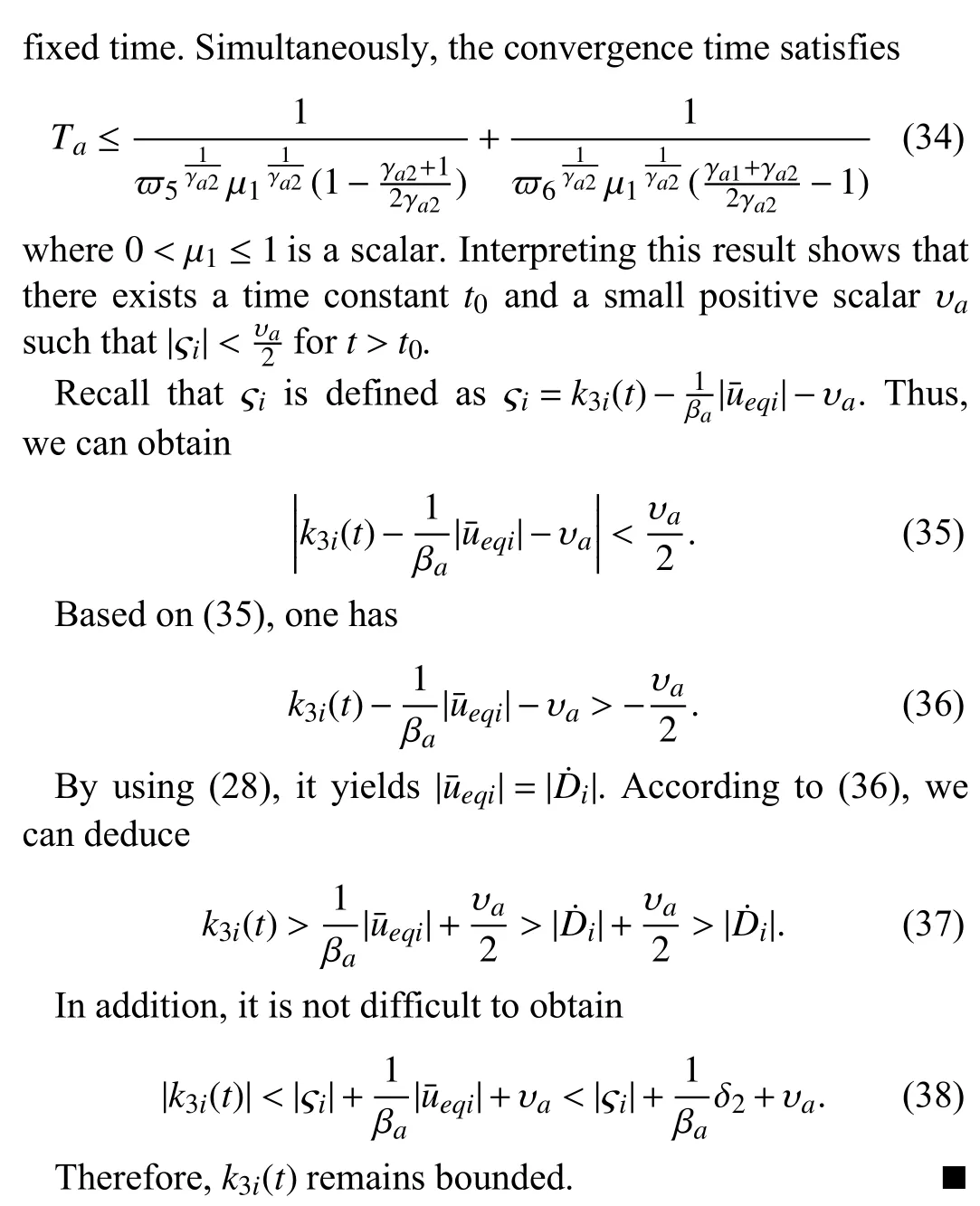
Remark 2: The signal value of |u¯eqi| is estimated by a lowpass filter, which enhances the robustness of the adaptive mechanism.Based on (28) and (29),k3i(t) will gradually increase until sliding motion occurs, and then it starts to decrease and eventually converges to the safety margin.By adjusting parameters βaand υa, the safety margin is changed to meet the requirements of different engineering environments for allowable uncertainties, such as [42].
Remark 3: The designed adaptive scheme described in (28)and (29) is motivated by [42].Note that the nonlinear lowpass filter mentioned in the above literature is also used as an estimator to give a close approximation of the switching signalueqin real time.The original design approach of the mentioned filter was derived from [43].However, the above design can only achieve finite-time stability.Compared with[42], the proposed adaptive scheme can provide fixed-time stability, so that the dynamic system has better convergence performance.
Remark 4: In fact, the parameter perturbation and external disturbance in industrial robot systems will adversely affect the control performance.To overcome this problem, the disturbance observer was designed in the [31]-[33].It should be noted that the conventional disturbance observer is difficult to estimate the unknown disturbance within a fixed time and the estimation accuracy is not satisfactory.Therefore, a AFTDO is designed in this paper.Compared with [35]-[37], this design can provide higher estimation accuracy.
C. Novel Design Approach of FTNFTSMC
The tracking error of the manipulator is defined as ε1=q-qd, whereqdis the reference position vector.The derivative of ε1is defined as ε˙1=ε2.Subsequently, the error system is given by
To ensure that the tracking error in (39) quickly converges to zero and overcomes the singularity problem, a new NFTSM surface is designed as
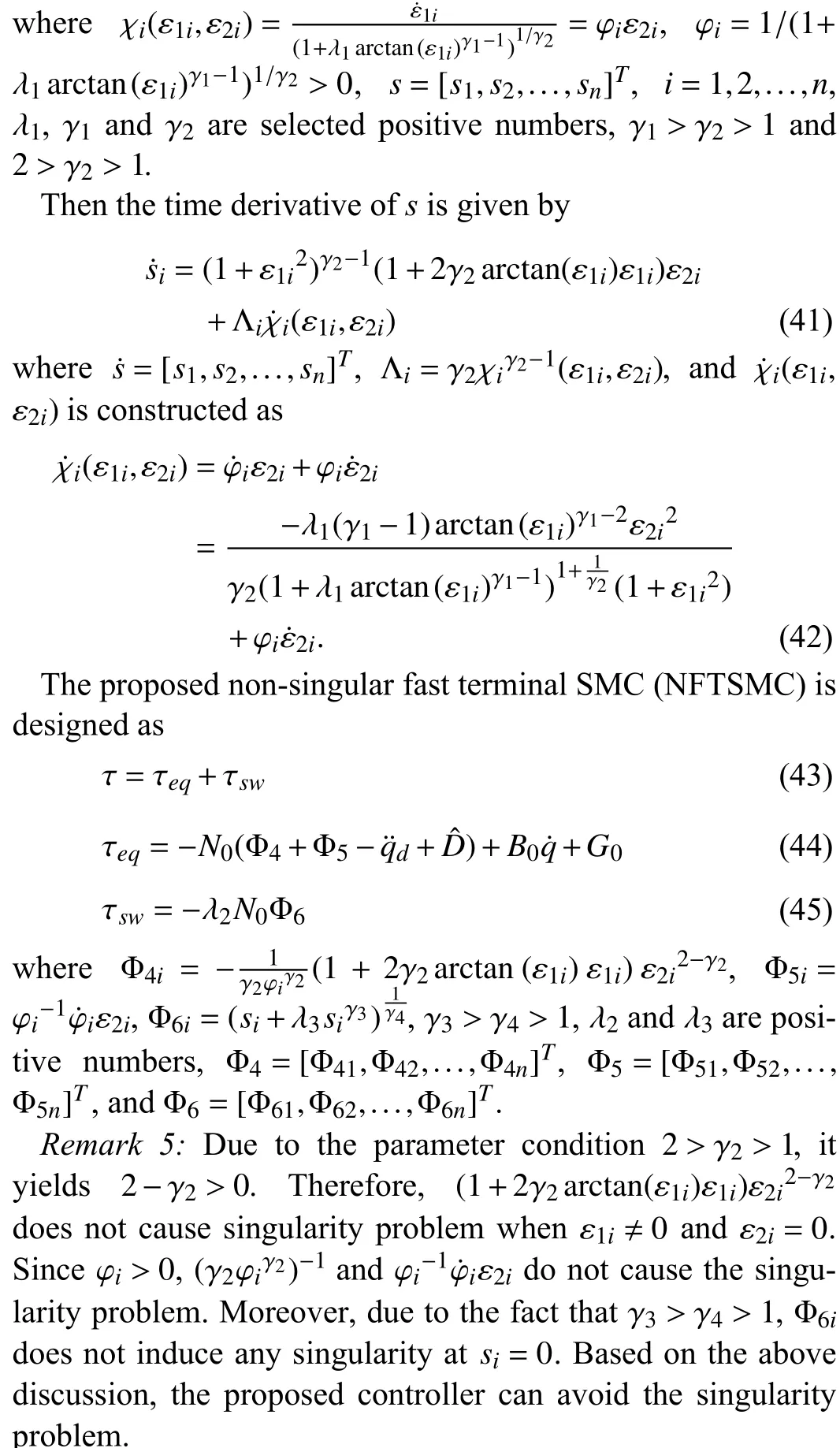
The specific control block diagram is presented in Fig.1.
Theorem 3: Consider the manipulator system (9) with system uncertainties and external disturbances.If the AFTDO in(17), (28) and (29), the NFTSM surface in (40) and the FTNFTSMC in (43)-(45) are used, the fixed-time arrival of the sliding surface is achieved and then the tracking error converges to zero within a fixed time.
Proof:The stability analysis of the reaching phase is described below.
First, a Lyapunov function is constructed as follows:
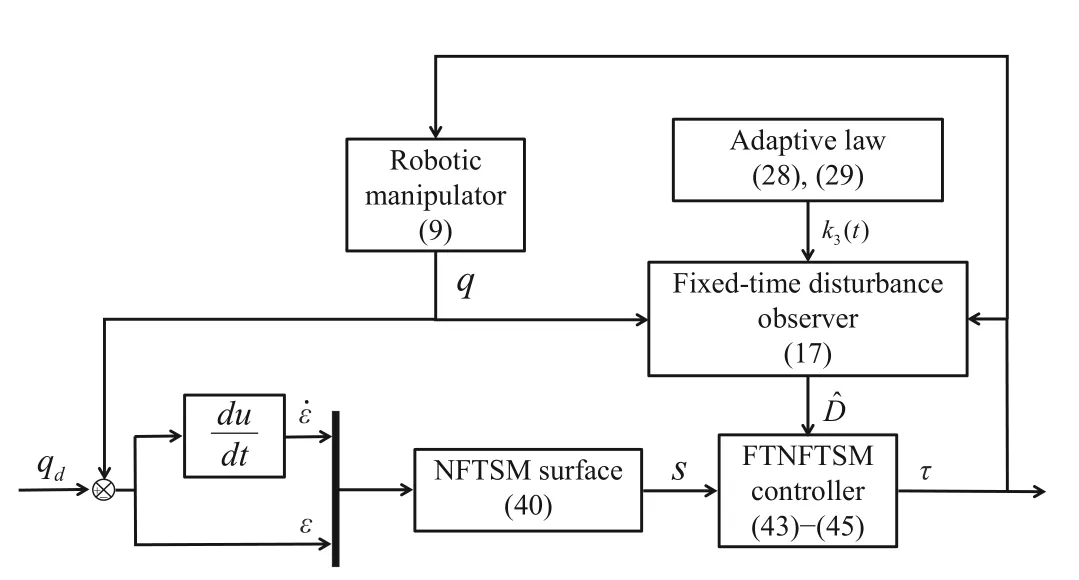
Fig.1.Block diagram of FTNFTSM control strategy.
DifferentiatingVrwith respect to timet, which has

The stability analysis of the sliding phase is described below.
Once the state trajectory converges to the NFTSM surfaces=0, it means that the trajectory tracking enters the sliding phase.Then we have
Defining Θ =arctan(ε1i), it yields
By calculating the results in (53), one obtains
Then the Lyapunov function is constructed as
The time derivative ofVsis

Therefore, the error system (39) is fixed-time stable by using FTNFTSMC.The complete convergence time is bounded by
Remark 6: The NFTSM design introduced in (40) is motivated by [17].However, the above control scheme can only achieve finite-time stability, which results in the convergence time of the system is limited by the initial state.Compared with [17], the proposed control scheme can ensure faster convergence speed and achieve global fixed-time stability.
Remark 7: The singularity problem is a challenge to be overcome in TSM control, which will not only cause serious overharmonization and increase control loss, but also lead to the collapse of the controlled system, resulting in bad effects.In [19], [20], [26], and [28], the piecewise function method was adopted to eliminate this defect.It should be noted that this method requires careful consideration of the continuity and differentiability of nonlinear functions, which increases the complexity of singularity avoidance.Compared with [19],[20], [26], and [28], the NFTSM surface designed in this paper does not need to combine piecewise functions and can conveniently avoid the singularity problem.
Remark 8: In brief, the advent of robotic manipulators has accelerated the process of automatic production.However,there are also a variety of uncertain factors in the real factory,which can easily deteriorate the control performance.For example, the nonlinear friction between the individual motion mechanisms of robotic manipulators will affect its dynamics model during operation, which may lead to the uncertainty problem in the robot system.In addition, the wear of mechanical parts can easily cause parameter perturbation in the robotic manipulator system, resulting in modeling uncertainty.Therefore, a new AFTDO is designed to estimate the lumped disturbance.This AFTDO can ensure the fixed-time convergence of estimation errors and has the characteristics of fast estimation speed and high estimation accuracy.Simultaneously, a fixedtime NFTSM (FTNFTSM) control scheme is used to enhance the robustness and improve tracking performance.Furthermore, there is no chattering problem in the actual control input signal.Therefore, the proposed FTNFTSM control strategy is feasible, and it is suitable for practical applications.
IV.SIMULATION RESULTS
A. Validation of the Proposed FTNFTSMC
In this section, the 2-link rigid manipulator shown in Fig.2 is used to visually demonstrate the feasibility of the FTNFTSM control strategy.In addition, numerical simulations are completed on MATLAB/Simulink with the numerical method Ode45.The dynamic model is given by


Fig.2.Architecture of 2-link robotic manipulators.


TABLE I CONTROL PARAMETERS OF FTNFTSM METHOD
Figs.3 and 4 show the position tracking and velocity tracking of the reference trajectory by the two links respectively,and the time responses of the tracking errors are presented in Fig.5.It can be seen that even if manipulators are perturbed by system uncertainties and external disturbances, good tracking performance is achieved by using the FTNFTSMC, that is,the actual position and speed of manipulators are quickly adjusted to the desired signal.The trajectories of control torques are plotted in Fig.6, where it shows that the chattering problem has been overcome.
Fig.7 depicts the response curves of the sliding surface,which implies that the NFTSM variablesis quickly regulated to zero under the action of the FTNFTSMC.The estimation errors of the AFTDO are presented in Fig.8.Interpreting these estimations results means that the AFTDO proposed in this paper can not only achieve rapid estimation of lumped disturbance, but also provide high estimation accuracy.The satisfactory estimation performance also provides sufficient guarantees to achieve better control performance.As shown in Figs.3-8, it confirms that the FTNFTSM control strategy is feasible.In addition, it is worth mentioning that a priori knowledge about the upper bound of the lumped disturbance is not required to be known in advance by using a disturbance observer.
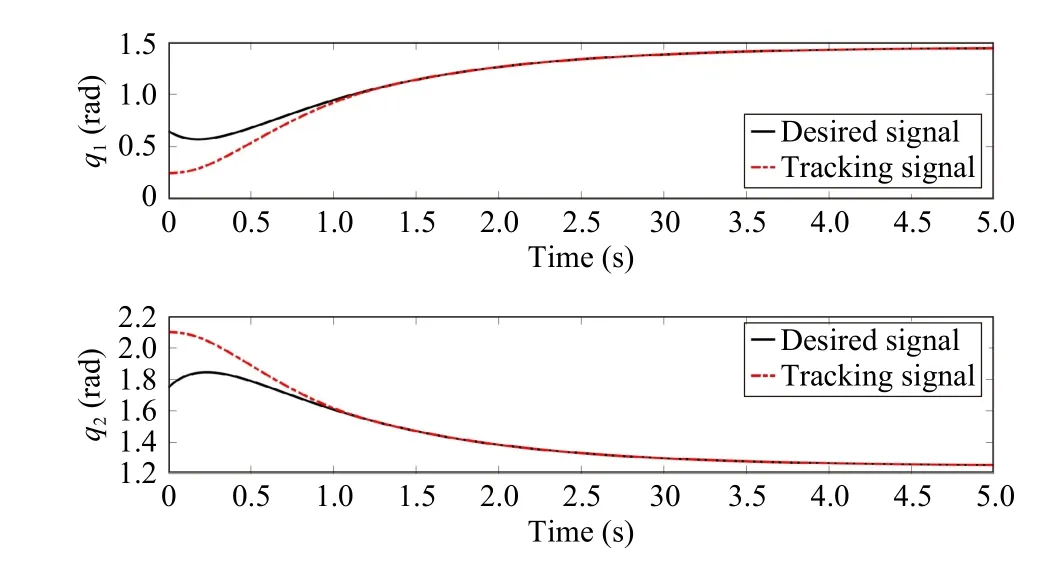
Fig.3.The trajectories of position tracking.

Fig.4.The trajectories of velocity tracking.

Fig.5.The trajectories of tracking errors.

Fig.6.The control torques of the two links.
In order to demonstrate that the proposed control scheme has the property of fixed-time convergence, trajectory tracking simulations are performed for five cases with different initial states of the robotic manipulator.In addition, the control parameters are still selected as shown in Table I.The five different initial states are set as follows.The simulation results are shown in Figs.9-13.

Fig.7.The trajectories of sliding surface.

Fig.8.The estimation errors of the disturbance observer.
Case 1:q(0)=[0.25,2.1]T,q˙(0)=[0,0]T;
Case 2:q(0)=[0.4,2.25]T,q˙(0)=[0.1,0]T;
Case 3:q(0)=[-0.1,2.3]T,q˙(0)=[0,-0.1]T;
Case 4:q(0)=[0.2,2.2]T,q˙(0)=[-0.1,0.15]T;
Case 5:q(0)=[1,1.5]T,q˙(0)=[0,0]T.
Figs.9-12 show the tracking response of the manipulator on the reference trajectory in five different initial states.Fig.13 depicts the control torque curves generated by the five different cases.From the results in Figs.10 and 12, it can be observed that the convergence time of the trajectory tracking error is almost the same when different initial values are chosen.Together with the stability analysis in Section III, these simulation results confirm that the proposed FTNFTSM control scheme has the capability of fixed-time convergence and the upper bound of the settling time does not depend on the initial state of the robotic manipulator system.
B. Comparative Results
To more intuitively demonstrate the excellent tracking performance of the proposed control strategy, the control schemes introduced in [17], [35], [36], [37], and [44] are selected as comparison examples.These control schemes use adaptive techniques, neural networks and disturbance observers to deal with the uncertainty problem in manipulator systems, respectively.Note that all simulation results are obtained under the same simulation conditions to ensure that the comparison results are reliable.In addition, three performance indices introduced in [19] are used to quantitatively analyze the comparison results, that is, the integral of the absolute value of the tracking error (IAE), the integral of the absolute value of the time multiplied by the error (ITAE) and the integral of the square value of the control input (ISV).The corresponding results are presented in Table II.

Fig.9.Position tracking trajectory based on different initial states.

Fig.10.Position tracking error based on different initial states.

Fig.11.Velocity tracking trajectory based on different initial states.

Fig.12.Velocity tracking error based on different initial states.

Fig.13.Control torque trajectories based on different initial states.

TABLE II QUANTITATIVE ANALYSIS OF DIFFERENT CONTROLLERS
The comparison results of six different control strategies are plotted in Figs.14-18.Figs.14 and 15 show the response curves for position tracking and speed tracking obtained by using six different controllers.The comparative simulation of position tracking errors is shown in Fig.16.It is easy to observe that Link 1 takes 1.3 s to track the reference position trajectory with the FTNFTSMC, while the other controllers take more than 2 s.For Link 2, it takes 1.2 s to track the reference position trajectory with the FTNFTSMC when the other controllers take about 2.5 s.Interpreting this means that the FTNFTSMC can achieve faster tracking speed.The results of quantitative analysis also confirm this advantage.As shown in Table II, the proposed control algorithm can produce smaller IAE and ITAE values.Fig.17 depicts the comparative results of control inputs given by six different controllers.From Fig.17 and its zoom-in graph, we can see that the FTNFTSMC provides a chattering-free control input signal.However, the chattering problem is not adequately addressed when using FTNTSMC (fixed-time NTSMC) and NFTSMC, which will adversely affect the control performance.In addition,compared with the other five controllers, the proposed controller produces lower ISV values in Table II, which implies that FTNFTSMC can guarantee better control input performance.Fig.18 shows the estimation errors of the lumped disturbance given by the four disturbance observers.From the zoomed-in graphs in Fig.18, it is clearly observed that the proposed AFTDO not only provides faster estimation speed,but also achieves higher estimation accuracy compared to the other three disturbance observers, which confirms its superior estimation performance.Therefore, we can conclude that the FTNFTSM control algorithm designed in this paper is feasible and achieves faster tracking speed, higher tracking accuracy and chattering-free control input.

Fig.15.Comparative results of velocity tracking.

Fig.16.Comparative results of position tracking errors.

Fig.17.Comparative results of control torques.
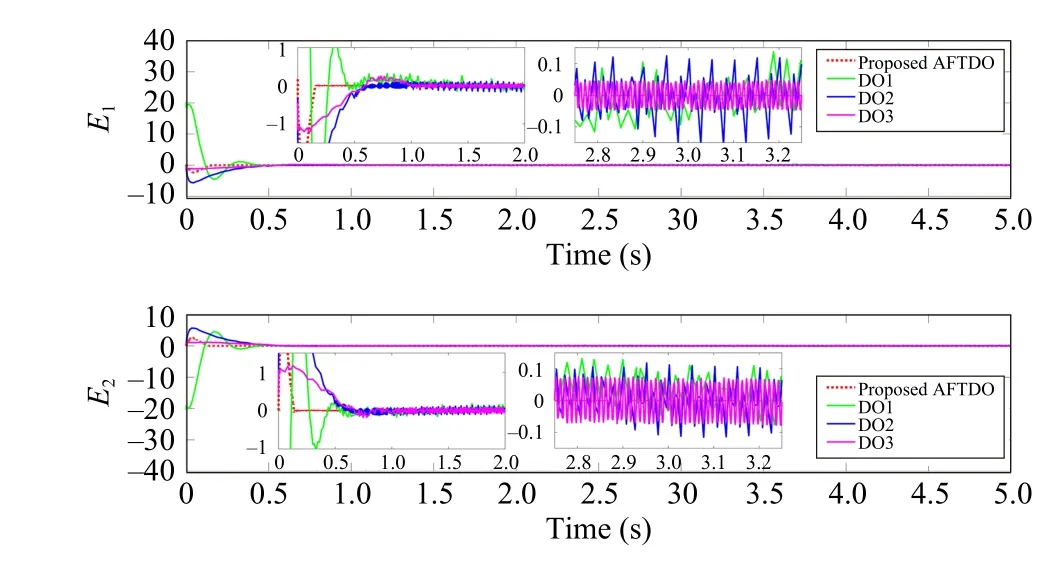
Fig.18.Comparative results of disturbance estimation errors.
V.CONCLUSION
In this paper, a new global FTNFTSM control strategy has been proposed for robotic manipulators perturbed by modeling uncertainties and external disturbances.To eliminate the adverse effects of lumped disturbance, an AFTDO is designed, which has been proved to have better estimation performance and can achieve fixed-time convergence of estimation errors.By combining fixed-time control, a new NFTSM surface based on an arctan function has been developed, which avoids the singularity problem expediently and enhances the robustness of the system.The fixed-time NFTSM controller based on the AFTDO has been designed to ensure that the tracking errors of manipulators can converge to zero within a fixed time.In addition, the setting time is bounded and its upper bound is not constrained by initial system states.The manipulator system is shown to be globally fixed-time stable and the stability analysis has been rigorously proved by Lyapunov method.Finally, the FTNFTSMC is validated on the 2-link manipulator.The simulation results have proved that the FTNFTSMC has excellent control performance.Future research attention will be focused on the fixedtime cooperative control of multiple robotic manipulators, and the issues of packet losses, delays will be addressed.
杂志排行
IEEE/CAA Journal of Automatica Sinica的其它文章
- A Dual Closed-Loop Digital Twin Construction Method for Optimizing the Copper Disc Casting Process
- Adaptive Optimal Output Regulation of Interconnected Singularly Perturbed Systems With Application to Power Systems
- Sequential Inverse Optimal Control of Discrete-Time Systems
- More Than Lightening: A Self-Supervised Low-Light Image Enhancement Method Capable for Multiple Degradations
- Set-Membership Filtering Approach to Dynamic Event-Triggered Fault Estimation for a Class of Nonlinear Time-Varying Complex Networks
- Dynamic Event-Triggered Consensus Control for Input Constrained Multi-Agent Systems With a Designable Minimum Inter-Event Time
